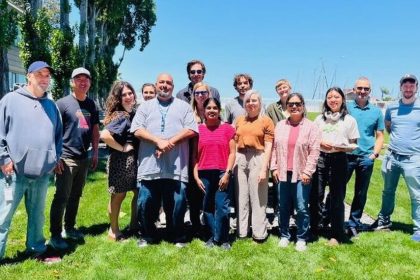In the world of fiction, SuperPowers often emerge from tragedy. That theme mirrors the real-life story of Roger E. Pedersen, a former video game designer who turned homelessness into inspiration, crafting a sprawling literary universe where flight and invisibility are more than just powers — they’re metaphors for the human condition.
Five years ago, Pedersen hit rock bottom. After losing his job, home, vehicle, and partner, he found himself living in a New York City homeless shelter. With little more than a laptop and a relentless curiosity, he stumbled upon a question he’d seen repeated in magazines, movies, and interviews: If you could choose one SuperPower, would it be the ability to fly or to become invisible?
Unlike most, Pedersen didn’t just ponder the question — he built an entire saga around it.
That idea became the foundation for SuperPower: The Ability to Fly or to Become Invisible, an ambitious six-book series that blends superhero tropes with social commentary, philosophical depth, and rich character development. The third installment, The Golden Eagle Has Yielded, takes the story to new heights, both literally and emotionally.
Pedersen’s background in game design is evident in how his books are structured. Back in the 1990s, he created the Coffee Break game series, a collection of short, numbered games that earned cult status. That experience influenced his writing style, making each numbered book in the SuperPower series feel like a puzzle. Hidden throughout the narrative are embedded games and cultural references, challenging readers to identify nods to classic films, books, and songs.
This interactivity isn’t just a gimmick — it’s part of what makes Pedersen’s storytelling immersive. It rewards readers who pay attention and adds layers of meaning that turn casual fans into obsessed followers.
Each book includes characters with unique powers, backstories, and motivations. Many are named after pop culture icons or personal connections, like Michelle Locke, a British Olympian who discovers her SuperPower mid-jump, securing a gold medal. At the same time, her mother wakes from a coma. The scene has brought readers to tears and represents what Pedersen does best: combining fantastical moments with raw human emotion.
Book three, The Golden Eagle Has Yielded, centers on Professor Steele and his nephews, Rocky and Apollo — key figures in the Golden Eagle Organization, a group that operates in moral contrast to their rivals, the genetically engineered DODGE initiative. At its core, the story is about power, legacy, and identity. Are superhuman abilities a gift or a curse? Can people be trusted with extraordinary power, or does it inevitably corrupt them?
Pedersen explores these themes through a global lens; characters journey from Iceland to India and from Paris to the Moon. His settings are thoroughly researched, covering everything from the geology of Iceland’s waterfalls to the physics of lunar energy sources, such as Helium-3. In the first SuperPower book, The Deal of the Art, Professor Steele and the world’s legendary art curator plan to acquire the top art museums globally for $3.5 billion in masterpieces from New York City, Paris, and London. His commitment to detail grounds the story, adding weight to the fantastical elements.
Yet, for all its scale, the heart of the series lies in its characters. In book three, both Rocky and Apollo Steele fall for the same woman, Myrena Gorgona, a SuperModel with the SuperPower to adapt — whether she needs to be invisible, fly, or use other powers. Their romantic rivalry unfolds through elaborate international dates, featuring glaciers, geysers, and gourmet dinners, all laced with flirtation, philosophy, and power dynamics — until all hell breaks loose.
Pedersen’s love for literature and mythology is evident. He weaves in references to Shakespeare, Hercules, and Greek mythology, creating a narrative that feels timeless despite its futuristic scope.
Surprisingly, Pedersen doesn’t “write” in the traditional sense. Using a speech-to-text app, he records the first and last chapters of each book, then crafts the “middle” to connect them. He calls it his “Oreo method” — with the beginning and end as the chocolate cookies, and the story in between as the creamy filling.
It’s a method that works. Pedersen has published six books in the SuperPower series, with more on the way — each over 400 pages. Despite the sci-fi premise, his goal is simple: “I want my readers to learn and laugh. If I can make you do both — and maybe cry a little — I’ve done my job.”
The cinematic nature of the SuperPower series hasn’t gone unnoticed. All books are listed on StoryRocket.com, a platform that connects authors with producers, directors, and other industry professionals. Pedersen’s work is backed by a two-time Emmy-winning producer, making a screen adaptation a very real possibility.
“I write my books to feel like movies,” Pedersen says. “I want readers to put the book down and pick it back up 10 minutes later because they just have to know what happens next.”
At its core, Pedersen’s story is not just about superheroes. It’s about resilience, reinvention, and the human urge to matter. From homelessness to publishing deals, from coding games to crafting literary sagas, Pedersen has proven that rock bottom is not the end — it can be the beginning.
So, which would you choose: to fly or to become invisible?
Pedersen’s answer isn’t clear-cut. But through his books, he’s made one thing certain: no matter what SuperPower you choose, it’s what you do with it that counts.
The SuperPower book series is available as an eBook, audiobook, and paperback from Amazon, Google Play, Apple, Barnes & Noble, Kobo, Target, Walmart, Waterstones, and hundreds of local bookstores.
Website: PSIPublish | StoryRocket







